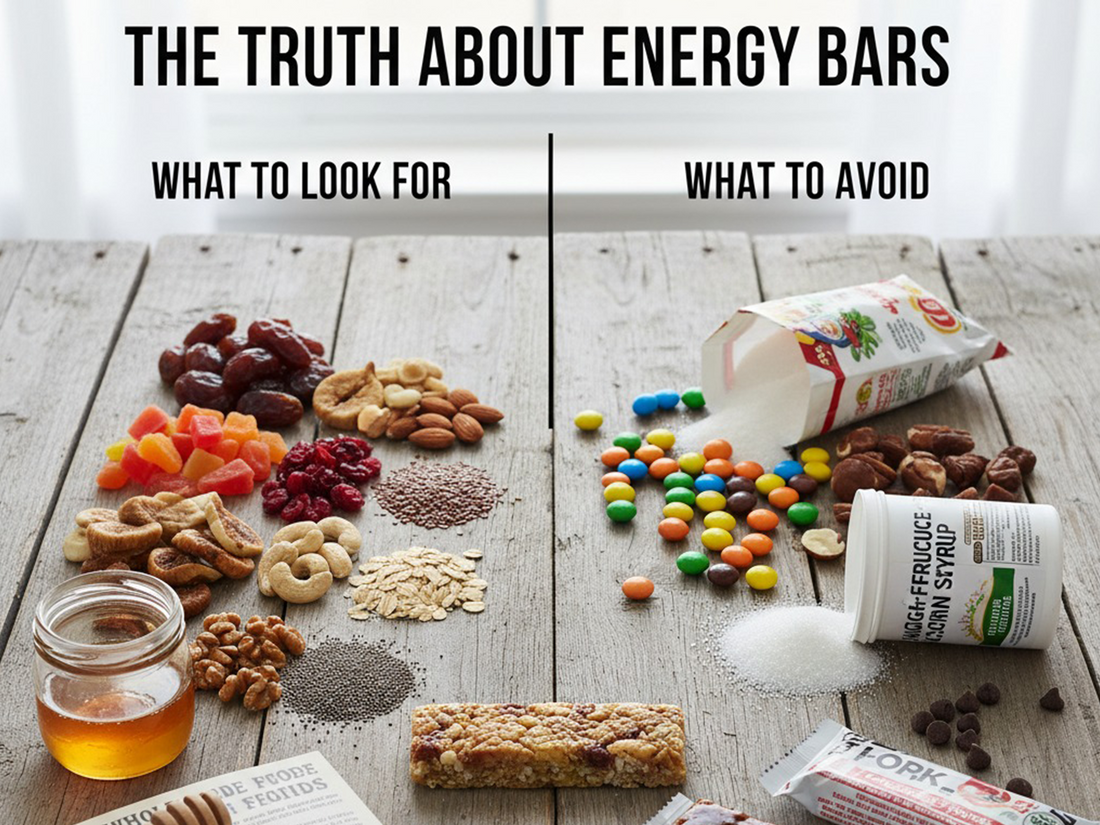The Truth About Energy Bars: What to Look For (and What to Avoid)
Walk down any supermarket aisle, and you’ll see a wall of energy bars staring back at you. They all claim to be healthy, natural, and “perfect for busy people.”
But if you’ve ever turned one around and tried reading the label, you probably ended up wondering: what even is half of this stuff?
The truth is, not all energy bars are created equal. Some are packed with good stuff that actually fuels your body, while others are just glorified candy bars hiding behind healthy-looking wrappers.
So how do you tell the difference? Let’s break it down — what to look for, and what to avoid when choosing your next bar.
Start With the Ingredients — The Shorter, The Better
If the ingredient list reads like a paragraph, that’s your first red flag. Real food doesn’t need a novel to describe it.
A good natural ingredients bar should have a handful of things you actually recognize — oats, nuts, honey, fruits, maybe a little sea salt.
That’s it.
If it’s full of words you can’t pronounce — like maltitol syrup, glycerin, soy protein isolate that’s a big hint it’s more processed than it looks.
The best rule?
If you wouldn’t use it in your kitchen, you probably don’t need it in your bar.
Sugar: The Sneaky Villain
Here’s a fun fact (or not-so-fun one): many so-called “healthy” bars have as much sugar as a doughnut.
Brands love to hide it behind fancy names — brown rice syrup, cane juice, fructose, malt syrup.
But your body doesn’t care what you call it; sugar is sugar.
Now, natural sugar isn’t bad — especially when it comes from fruits, dry fruits, and veggies. That’s the kind of sweetness your body understands and processes slowly.
So when checking labels, look for fruit-based sweetness (like dates or raisins) instead of added sugars. It makes a world of difference in how steady your energy feels afterward.
Protein: Quality Over Quantity
Everyone loves a bar that says “20g protein” in big bold letters. But where’s that protein coming from?
If the label mentions “whey isolate” or “soy concentrate” before real food ingredients, it’s probably more about marketing than nutrition.
Bars made from nuts, seeds, and oats give you natural protein — the kind that digests slowly and fuels your muscles the right way.
You don’t need the highest number of grams; you need the cleanest source.
Fats: The Good Kind Only
Fats aren’t bad — the wrong fats are.
Look for bars with healthy fats from nuts, seeds, or coconut. Avoid anything that lists “palm oil,” “hydrogenated oil,” or “vegetable shortening.” Those are just processed fillers that do more harm than good.
Healthy fats are your energy’s best friend. They help you stay full, focused, and balanced without the crash that comes from sugar-heavy snacks.
Fiber: Your Secret Weapon
Most people don’t get enough fiber, and that’s one thing a great energy boost bar can help with — if it’s made with real ingredients.
Fiber slows down digestion, keeping your blood sugar steady and your energy stable.
But watch out for “added fiber” from synthetic sources — that can upset your stomach. The best kind of fiber comes naturally from oats, fruits, and nuts.
If your bar includes those, you’re good to go.
Artificial Additives: Just Say No
Here’s where many bars lose the “healthy” title.
Artificial flavors, colors, or preservatives — they’re not there for your benefit, they’re there to make the product look prettier and last longer.
If your snack bar needs bright colors or “enhancers” to taste good, it’s not real food.
Instead, stick with options that use real flavors — cocoa, cinnamon, or dried fruits. They taste better, they’re natural, and your body won’t have to work overtime figuring out what you just ate.
Texture and Taste: Real Food Feels Different
You can often tell a lot about a bar just by how it feels and tastes.
If it’s too chewy or plasticky, chances are it’s packed with binders and sweeteners. A real bar — made from fruits, dry fruits, and veggies — should taste like something you could’ve made at home.
Soft, slightly sticky, and full of natural flavor. That’s the kind of texture that tells you it’s real food — not a lab creation.
Energy That Lasts (Not the Sugar Rush Kind)
Here’s what separates the good from the fake.
Real energy doesn’t hit you hard and disappear. It builds slowly and lasts for hours.
A natural ingredients bar that uses real carbs, protein, and fats gives you that balanced energy — steady, reliable, and calm.
On the other hand, bars loaded with sugar or syrups will make you feel great for 30 minutes, then crash you harder than your WiFi on a rainy day.
So when in doubt, go for something that feels natural in your body — not something that gives you a fake buzz.
Marketing Tricks to Watch Out For
Ah yes, the front of the wrapper — where brands turn into poets.
“Sugar-free!” “High-protein!” “All-natural!”
Sounds amazing, right? Until you read the back and find out the “natural flavor” comes from a lab, and the “sugar-free” part is just replaced by artificial sweeteners.
So here’s the rule: ignore the front, read the back.
That’s where the truth lives.
Why Simple Always Wins
In the end, the best snacks are the simplest ones. You don’t need 25 ingredients to stay full and energized.
You just need real ones.
Think about it — a bar with oats, nuts, honey, and dried fruit gives you natural sweetness, clean fats, and lasting energy.
That’s what a good energy boost bar does. It keeps things simple, clean, and close to nature.
When your food is real, your body knows what to do with it.
